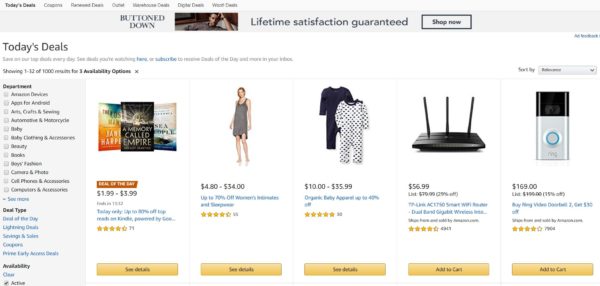One of the most visited pages on all of Amazon is the “Today’s Deals” page, where customers are able to quickly see the deals across Amazon for that day. For sellers, they are able to pay their way on to this page by creating what are called “Lightning Deals” found under the advertising tab in Seller Central. This allows a product to be listed on the “Today’s Deals” page for 6 hours. The question is for sellers, is the price of admission worth it for the extra sales you receive? We compiled data from our own experiences with our clients, as well as researched what other reports have said. So, let’s find out.

Lightning Deals Page
How much do Lightning Deals cost?
There are two costs to account for when calculating the cost of a Lightning Deal. First is the flat fee Amazon charges to access the “Today’s Deals” page. Currently you can expect to pay $150, however the price can go up to $300 or more based on seasonality and overall demand.
The second cost is how much you will be discounting off of your regular listing price. The minimum discount required is 15%, but most sellers typically discount in the 20-35% range for better results.
How much of a boost can you expect in sales?
A major boost. In our experience established products can expect to get anywhere from 2-4x their regular daily sales, even more so for newer products that haven’t hit their stride yet.
Do sales increase after the Lightning Deal is over?
Due to the upfront cost and margin lost from discounting your products, you would ideally like to see somewhat of a continuation of the sales momentum after the Lightning Deal is over. In our research and experience, this does not appear to be the case.
In fact, on average product sales for the next week after running a Lightning Deal either go back to where they were before the sale, or often drop 5-10%. We believe this could be because there were customers who were likely to buy your product at its normal price anyways, and so they jump at the opportunity during the sale. You essentially took some sales that were going to happen the next week, and pulled them forward by offering a discount.
The true cost of a Lightning Deal: Case Study
Let’s take a look at an example of what you can expect when running a Lightning Deal, and what the true cost is when you include the ad fee as a part of the discount you are giving. For example: if you sold 50 units, the $150/50 = $3 per unit.
- Product X normal selling price: $24.99
- Product X cost of goods: ~$10
- Lightning Deal sale price: $19.99
- Lightning Deal ad fee: $150
- Units sold during Lightning Deal: 67
- Fixed fee per unit: $150/67 = $2.24
- Total fees per unit added up including referral fee and FBA fees: ($19.99*0.15) – $2.24 – $2.48 = $7.72
- Profit per unit: $19.99 – $7.72 – $10 = $2.27
In this case the Lightning Deal was a success because the seller was able to run the deal while still having margin left over. This is not always the case, and this seller made much less per unit than normal. Which leads to our conclusion, and the original question posed: “Are lightning deals worth it for Amazon sellers?”.
Pros and Cons of Lighting Deals
Pros:
- You get product and brand exposure on one of the most visited pages on Amazon
- A potentially good way to boost sales for new products to increase word of mouth and get more reviews
- Increase Best Seller Ranking (BSR) temporarily, giving you a boost in search rankings
Cons:
- Can be expensive and often will lose you money
- Does not improve long term sales or rankings, products almost always go back to where they were before the Lightning Deal
- You have no control when your Lightning Deal will be, has a chance of being in the middle of the night when fewer people are browsing Amazon
Conclusion
Lightning Deals are not a magic bullet that will instantly turn your product into a best seller, they are simply another tool in the toolbox. The best case for using them are new products that need to gain traction and get “Verified Purchase” reviews early on. This could be a better option than what many sellers do, which is create giveaways for their products often discounting them 80-90%. For already established products, the money spent on Lightning Deals is in most cases better spent elsewhere on advertising opportunities that create longer lasting effects.




